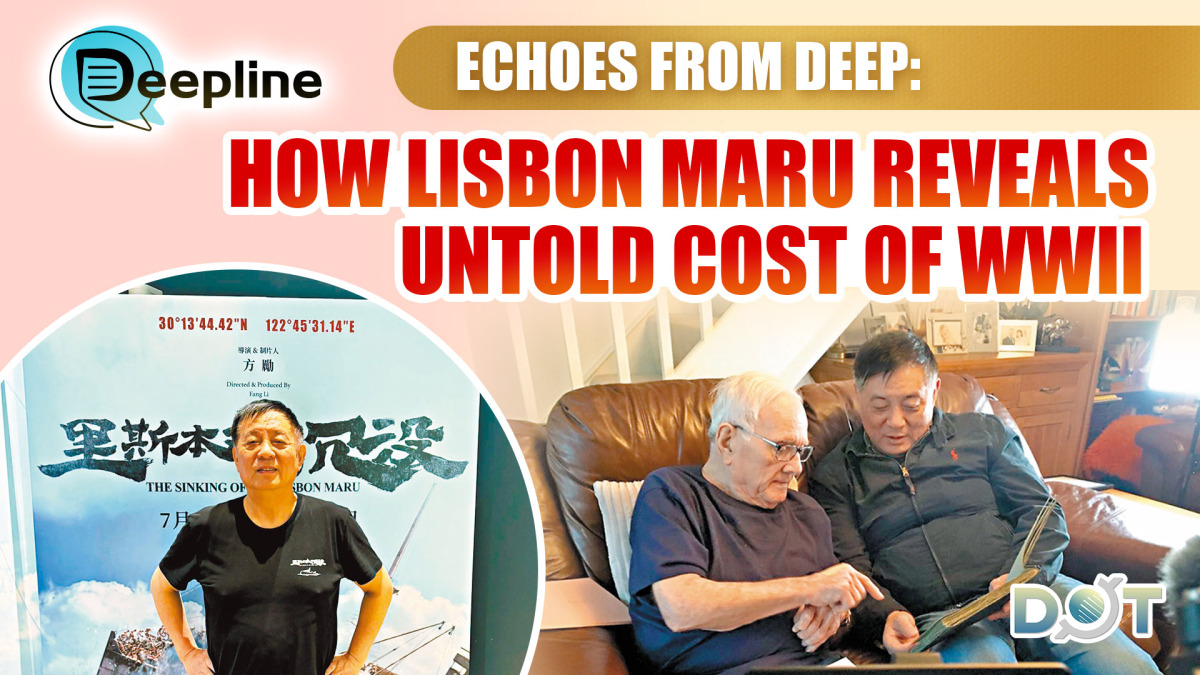
The documentary film The Sinking of the Lisbon Maru will be released across Hong Kong on July 24, with its premiere recently held in the city. The film's significance is further highlighted as it debuts during the special occasion of the 80th anniversary of the victory in the War of Resistance—it serves as a reminder to cherish the hard-won peace and to reflect on the fact that war has never truly left humanity. Behind the film lies the relentless pursuit of producer and director Fang Li, who transcended borders and delved deep into the dust of history.
When asked why he chose to make this documentary about a WWII shipwreck, Fang said, "My connection with the Lisbon Maru began in 2014." At the time, he was active in the film industry as a feature film producer and happened to hear about the legend of this WWII shipwreck from a captain. Out of curiosity, after wrapping up the filming of The Continent, he asked local friends for confirmation and was told, "It's a true story." After searching online, Fang came across Tony Banham's book The Sinking of the Lisbon Maru: Britain's Forgotten Wartime Tragedy, and a long-buried piece of history gradually came to light.
In 1942, during the Pacific War, Japan requisitioned the cargo ship Lisbon Maru to transport over 1,800 British prisoners of war from Hong Kong to mainland Japan for forced labor. On October 1, 1942, while sailing near the Zhoushan Archipelago in Zhejiang, China, the ship was mistakenly identified as a Japanese warship by the American submarine USS Grouper and struck by torpedoes. The Japanese initially sealed the ship's holds, leading to the drowning of many prisoners. Later, as the ship took on severe water, some prisoners were transferred, but the vessel ultimately sank.
After the sinking, fishermen from Dongji Island in the Zhoushan Archipelago risked their lives to rescue over 300 surviving prisoners. The Japanese later landed on the island to recapture them, and most of the rescued prisoners were still sent to Japan for labor. Due to wartime information suppression, the truth of the incident remained buried for a long time, and the bravery of the Chinese fishermen was rarely mentioned until recent years, when it began to be rediscovered.
Deep paternal empathy as emotional drive
In 2016, Fang took a break from his schedule to organize a team of over a dozen people to search for the shipwreck's remains, but they failed due to incorrect coordinates in Japanese military records. In 2017, Fang returned with more advanced equipment and invited two television crews, finally successfully verifying and locating the wreck.
However, what truly ignited Fang's creative fire was not just the discovery of the shipwreck. On the afternoon of Sept. 9, 2017, as Fang left the water and stood on the deck, a powerful realization struck him—he became acutely aware that beneath the cold waters lay the forgotten remains of 828 young lives. That year, Fang's son was 22 years old. As a father, he couldn't help but think of these young men, around his son's age, who had traveled thousands of miles through China only to perish at sea.
"These people deserve to be known, to be remembered." This profound paternal empathy became the raw emotional drive behind his work.
A sense of urgency followed. After returning to Zhoushan, Fang learned that Lin Agen, the last surviving Chinese fisherman who had participated in the rescue, was already 94 years old and his memory was fading. What pained Fang even more was that, at the time, there were only two surviving veterans of the Lisbon Maru incident worldwide, one of whom was 98-year-old Dennis Morley.
"If we don't act now, we might lose these witnesses forever."
British newspaper ad seeks families of victims
In early 2018, Fang flew to the UK and enlisted a military consultant to help bridge connections with the victims' families. After the Lunar New Year, the team began intensive interviews with the families. The process profoundly changed Fang's perspective.
Immersed in tears daily, he listened to heartbreaking stories of endless waiting and longing, leaving him deeply moved. "These are details no screenwriter could imagine and emotions no actor could portray."
But the challenge was that Fang's team had only about 20 families on their list, far fewer than the number of victims. He decided to place a notice in a mainstream British newspaper, targeting older generations who were more likely to read print media. The ad sparked a strong response, with outlets like the BBC picking up the story and broadcasting it globally.
Information spread rapidly, and contact details from families poured in, eventually reaching over 380 families. To their surprise, they even found a surviving veteran, William Beningfield, living in Canada. The emergence of these precious individuals made Fang realize that this project was no ordinary "task"—it had become an inescapable mission. He resolutely committed himself to this path of questioning history and uncovering the truth.
Fang said, "Among the many testimonies, three individuals left the deepest impression on me. One was Lin, a simple Chinese fisherman who participated in the rescue of the British soldiers. He recounted the events with remarkable calm, describing saving so many lives as 'natural' and 'the right thing to do.' Despite their extreme poverty at the time, the fishermen gave everything they had to rescue the survivors and shared their precious food with them, deeply moving me. Another was Beningfield, a veteran living in Canada. When recounting painful memories, his hands would tremble, but he chose to face the future with optimism and refused to dwell on past suffering."
The third was Morley, who initially refused to speak about the past. It wasn't until Fang showed him a wartime photo of himself and his comrades in Hong Kong that he opened up. Despite being nearly 100 years old, Morley's gratitude toward the fishermen remained fervent. He recalled how his heart had hardened as he watched his comrades' bodies float in the icy water, never expecting the Chinese to appear. Fang promised him, "I will tell the world what you want to say," finally giving him the motivation to share his story. Beningfield also shared a horrific chapter of history not included in the film: the massacre at St. Stephen's College on Hong Kong's Stanley Peninsula.
During his research in Hong Kong, Fang also learned about this tragedy: on December 25, 1941, due to delayed communication of the British surrender order, the college—serving as a field hospital—was overrun on the morning of the 26th. Seventy-five people were slaughtered, medical staff were raped, and the headmaster's wife was beheaded for trying to stop the violence. This history lies buried in a mass grave at the Stanley Military Cemetery, a silent witness to the brutality of war.
Showcasing the radiance of humanity across borders
A central theme of the film is the courageous rescue of British prisoners by local fishermen despite immense risks. Fang emphasizes that the value of life is universally cherished. The fishermen acted on a noble tradition: when they see lives in danger at sea, they must help. This simple kindness, displayed under extreme circumstances, transcends nationality, culture, and race, shining with the universal radiance of humanity—a vivid embodiment of the "community with a shared future for mankind."
Fang mentioned that after the film's release, particularly in June 2024, the Chinese Embassy in the UK sponsored six descendants of British prisoners (with another 10 paying their way) to visit Shanghai. At the premiere's red carpet, Fang arranged for the son of a rescued British soldier to walk alongside the descendant of a fisherman. The two men, of similar age, stood together, symbolizing their fathers' fateful encounter at sea—one's father had saved eight British soldiers, while the other's grandfather had been rescued by fishermen. This handshake across time and space is the most powerful testament to the spirit of human solidarity.
Fang said he often receives hugs and thanks from British viewers. He believes that the Chinese civilians of that era were angels who saved lives, while his team of filmmakers are angels rescuing history—both are messengers of profound human virtue.
"I hope people cherish family and peace more"
The film involves four countries: China, the UK, Japan, and the U.S. Fang stresses that his creative intent was simple: to fulfill the wishes of the victims' families, honor the dead, commemorate the fishermen's bravery, and restore a history forgotten for 80 years. He clarifies that he did not set out to glorify Chinese fishermen or condemn Japanese atrocities but to present the truth.
On January 23, 2025, the film was screened at the British Embassy in China. A Japanese military attaché in attendance later texted Fang, saying that despite knowing the film depicted wartime brutality, he chose to watch it because it conveyed the message that "truth is truth, history is history, and we hope there will be no more war."
"My greatest wish is for audiences to leave the theater cherishing their loved ones, families, and peace more."
Fang also noted, "The Sinking of the Lisbon Maru has had a profound impact on the descendants of British soldiers. Many finally learned the exact location and circumstances of their fathers' deaths, understood why their fathers bore such deep postwar trauma, and felt gratitude toward the Chinese people." He has received over 150 thank-you letters from families, whose emotions found closure and healing after watching the film.
As the film debuts during the 80th anniversary of the victory in the War of Resistance, its significance is even more pronounced—it reminds people to cherish hard-won peace and reflect on the fact that war has never truly left humanity.
"The power of this film lies in its truthfulness; it withstands scrutiny of every detail." Fang sees himself as a relay runner of history: Tony Banham investigated the events, while he uncovered the human stories within them.
"Now," he says, "the media and audiences are the third baton, spreading this story of humanity and peace together."
(Source: Wen Wei Po; Journalists: Ding Ning; English Editor: Darius)
Related News:
US media: 180 Chinese films featured at Cannes Film Festival




















Comment